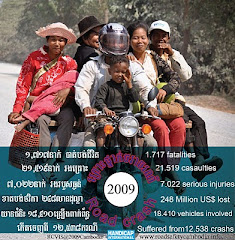Friday, May 28, 2010
Thursday, May 27, 2010
Wednesday, May 26, 2010
Michelle Yeoh calls for safer roads
Malaysian-born movie actress Yeoh advocates for road accident injuries to be recognised as a global public health and development priority.
She said the region was facing an epidemic of road accident deaths and injuries, adding that there were innovative Asian road safety solutions such as the International Road Assessment Programme, "which is transforming the way we understand safe road design", and the Global Helmet Vaccine Initiative.
"There is so much we can do to save lives on our roads," said the global ambassador for the "Make Roads Safe" campaign who is known for her roles in movies such as James Bond''s ''Tomorrow Never Dies'' and ''Crouching Tiger, Hidden Dragon''.
The ADB said in a statement that Yeoh was at the bank''s headquarters in Manila to participate in a three-day transport forum where leading experts from around the world discussed crucial issues facing transport in Asia and the Pacific.
ADB vice-president for Knowledge Management and Sustainable Development, Ursula Schaefer-Preussm, said each year, about 1.18 million people globally died in road accidents and 60 per cent of all road accidents occurred in the region.
"Equally notable is how this issue impacts the poor, who suffer gravely from unsafe roads, while remaining marginalised by transport policies that are bias in favour of private vehicles," she said.
The ADB said it had developed a new paradigm for sustainable urban transport that offered the prospect of much more effective management of the region's cities over the coming years.
The strategy includes a strong push for a people-focused "avoid-shift-improve" approach that promotes accessibility instead of mobility and manages demand for travel to supply instead of building more infrastructure for the seemingly unstoppable growth in private vehicles.
This involves developing an efficient land-use and transport system to help city dwellers avoid motor transport, a shift towards energy-efficient modes of travel, particularly public transport, and measures to improve vehicle and fuel technologies. -- BERNAMA
Monday, May 24, 2010
Speeding research
Crash Risk
Research1 has shown that the risk of a crash causing death or injury increases rapidly, even with small increases above an appropriately set speed limit.
Speeding greatly increases the risk of injury and death. Research on travelling speeds and crash involvement has calculated the crash risk of driving at certain speeds over the speed limit in a 60 km/h zone.
Risk of a casualty crash at speeds greater than 60 km/h, relative to travelling at 60 km/h, where the speed limit is 60 km/h. | ||
| Speed | Relative Risk | |||||||
|---|---|---|---|---|---|---|---|---|
| 60 | 1.00 | |||||||
| 65 | 2.00 | |||||||
| 70 | 4.16 | |||||||
| 75 | 10.60 | |||||||
| 80 | 31.81 | |||||||
| 85 | 56.55 | |||||||
For example a driver travelling at 65 km/h in a 60 zone is twice as likely to have a serious injury or fatality crash as a driver travelling at the speed limit. Driving at 70 km/h in a 60 km/h zone, the driver is more than 4 times as likely to crash.
Based on this research it can be concluded that
In a 60 km/h speed limit area, the risk of involvement in a casualty crash doubles with each 5 km/h increase in travelling speed above 60 km/h.
There are three reasons that small reductions in speed make such a large difference to risk.
1. Small differences in speeds mean differences both in time to collision and ability to avoid a crash.
Even if a vehicle cannot be stopped in the available distance, the collision can still sometimes be avoided. When a driver is speeding there is less time for both that driver and any other road user (either a pedestrian or another driver) to:
- Recognise danger
- Decide on an evasive action (brake, swerve)
- Complete the evasive action
Furthermore, a vehicle travelling at a higher speed is more difficult to manoeuvre.
2. Small differences in vehicle speeds, before braking begins, can result in large differences in impact speeds.
The diagram below shows the relationship between speed, stopping distance and impact speed. For each travelling speed both the stopping distance for vehicles travelling 50 km/h to 90 km/h are shown and the impact speeds for vehicles travelling faster than 50km/h at the point where the vehicle travelling at 50 km/h would have stopped (i.e. at 29m).
The following example illustrates how impact speed can differ between two cars with only a 10 km/h difference in travelling speeds:
...consider two cars travelling side by side at a given instant, one car travelling at 50 km/h and the other overtaking at 60 km/h. Suppose that a child runs onto the road at a point just beyond that at which the car travelling at 50 km/h can stop. The other car will still be travelling at 44 km/h at that point2.
3. Even small differences in impact speed make a large difference to the probability of serious injury.
The reason for this difference is that the force of the crash varies with the square of the impact speed. For example, a 70 km/h collision has about twice the force of a 50 km/h collision.
Speed & Alcohol Crash Risk Comparisons:
Researchers1 from the Road Accident Research Unit in Adelaide have calculated the comparable crash risks for speed and alcohol.
They determined that driving at 65 km/h in a 60 km/h speed zone exposes you to the same crash risk as someone with a Blood Alcohol Content (BAC) of 0.05; whilst travelling at 68 km/h is equivalent to driving with a BAC of 0.08.
Resource:RTA
